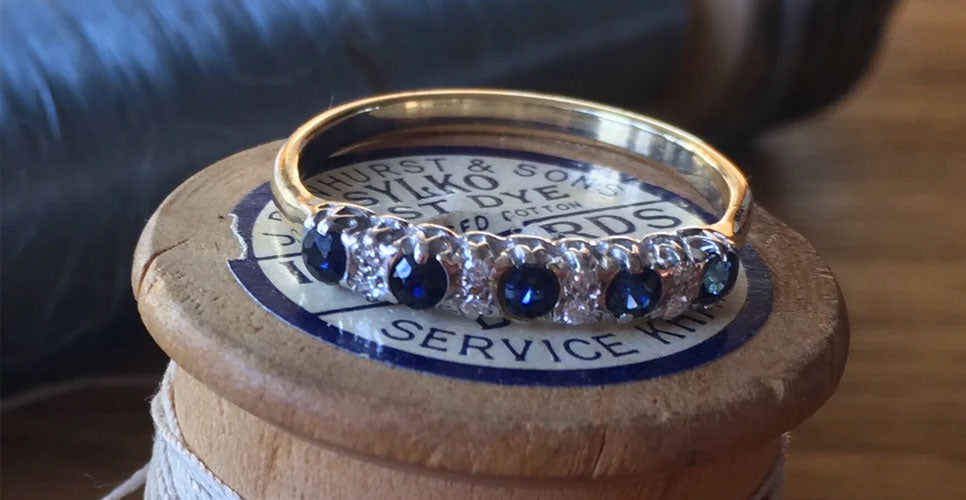
It can be heartbreaking when you notice a diamond missing from your ring, the thing you cherish the most. Your heart starts pumping, you retrace your steps but the diamond is well and truly gone.
This story is more common than you think. It can feel horrible at the time but it is nothing to be ashamed of if it happens to you. Keep reading to find out how you can stop this from happening to you.
But what to do to if a gemstone has already been lost? By getting in touch with Ruth to chat through, the stress is taken off your hands, and you can rest easy knowing your ring is being restored to its former glory.
Why metal can wear
Metal interacts with its environment. So the more knocks a ring takes, the more the metal wears down, even if it's just a few atoms at a time. The thinner the metal to start with, the quicker this can happen, which is why the most important area to look out for is the claws which hold your diamonds and other gemstones in place. Diamonds are set into place by pushing tiny amounts of metal, often in the shape of 'claws' over the edge of the diamond to hold it in place. Traditionally, settings are constructed so that the least amount of metal is used, in order to show off the diamond to maximum effect. Not all diamonds are claw set, but it's the most common type of setting for engagement rings ,and without regular servicing, these can wear down until they no longer hold the diamond in place. The design by Ruth Mary Jewellery below in white gold and tourmaline has some claw features but they are integrated into the overall design. As well as looking great, they are more secure.

How to stop diamonds falling out
The most effective way to keep your diamonds secure is to have your ring looked at by a professional stone setter once a year. A trained eye will be able to spot whether the claws are wearing too thin or whether they need adjusting to prevent the diamond from rocking from side to side. If your diamond begins to move within its setting, get it looked at before you lose it, especially if it is only held by 4 claws (like this dreamy aquamarine engagement ring).

Not all jewellers have an in-house specialist stone setter, so it's worth asking whether the jeweller you are speaking to is also a specialist stone setter. To have your ring checked, you can get in touch with Ruth, who will show it to her expert stone setter Leanda. Most stone setters in the jewellery industry are men and even today, female stone setters are hard to find. Shockingly, throughout Leanda's career, she was told she couldn't be a diamond setter because she is a woman, but she never took 'no' for an answer, and has honed her skills way beyond what is required to qualify as a diamond setter. So your ring will be in extremely safe hands.
When a diamond has fallen out, it's usually because the claws have worn too thin, so if you catch the claw on a towel while drying your hands, the claw bends away from the stone it is meant to be securing. This is where modern laser machines come in, allowing the claw to be reinforced with extra metal, without heating the entire ring and risking damage to other areas of metal or other gemstones themselves.
What if a diamond or other gemstone needs replacing?
The most common diamonds to fall out are the really tiny ones like those around the aquamarine in the picture above or around the pear cut diamond below, because there is less metal holding them in place. Although this can feel devastating if it happens to you, you're not alone and these 'one point' diamonds which weigh 1/ 100th of a carat are inexpensive to replace. They actually cost less than the cost to set the diamond.

If a bigger diamond or other gemstone is lost, it's not as simple as replacing like for like. Every gemstone formed by nature has natural variations which hugely influence it's value. The characteristics of diamonds are often described using the 'four C's' – carat weight, cut, clarity and colour. It can be a confusing experience, which is why Ruth Mary will ask you a few questions to narrow down the choices. The carat weight and cut will be based on the setting in which the stone will be set. So the focus will be on the clarity and colour. Because there is so much variation, especially amongst coloured gemstones, it's best to decide on a budget for the stone replacement, which Ruth can guide you on, depending on what's important to you. She will then find the best possible stone within your budget.
Have you got questions about your rings or would like an expert to take a look? Simply get in touch with Ruth directly here or if social media is your thing, then you can get in touch via Facebook, Instagram, LinkedIn or Twitter.


2 comments
Hi Rachel, that’s sounds so frustrating with the emeralds falling out of your nan’s eternity ring! Are you able to send me a picture of it? I’m about to email you in case you don’t see this. I’ll need to have a look at the settings that secure all the stones. Hopefully we can laserweld extra metal on the claws (if they are claw set) to make them a bit more secure. Look forward to chatting to you. I love working on sentimental jewellery pieces like that, your ring sounds like a real heirloom!
Ruth
My nans eternity ring was fine until our 20 th anniversary when I asked if we could have emeralds to replace some of the diamond , the jeweler said it would be fine there was diamonds all around now there is one diamond one emerald and so on throughout the ring . Problem is the emeralds keep falling out had it replaced so many times now the jeweller has said it’s because of the age . Obviously I’m angry as I would never have got it done had I known this . Can you think of a way for my ring to be safe to carry the emeralds . It’s v precious to me over 100 years old